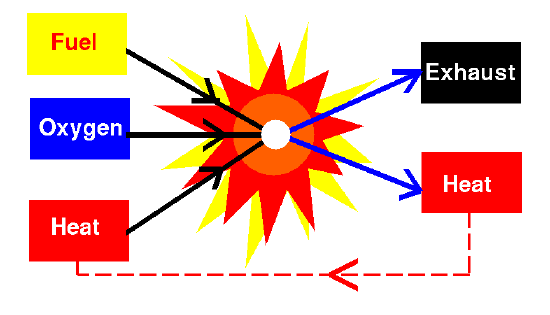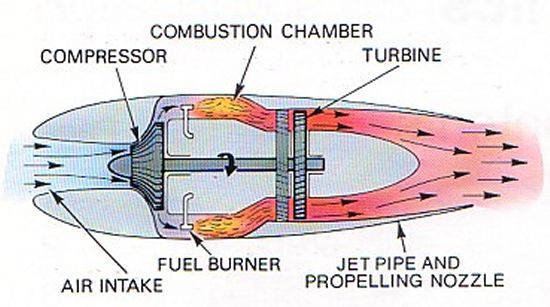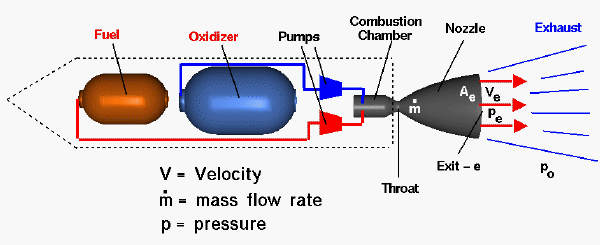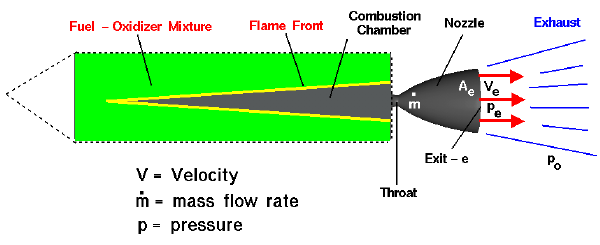Jet Engine
Monday, May 04, 2009

Simple representation of the combustion process
The purpose of both the jet engine and the rocket engine is to combust a mixture of fuel and oxidizer. This combustion process generates a high-pressure exhaust that creates thrust to push a vehicle forward. The fundamental difference between the two types of engines, however, is where the oxidizer comes from.
A jet engine obtains its oxidizer from the external atmosphere, as illustrated in the diagram below. Air enters the engine through an inlet and is then slowed down and compressed by a series of compressor blades. The compressed air is then mixed with fuel, typically a petroleum-based liquid similar to kerosene, and burned. The high-pressure gas is exhausted through a nozzle to generate thrust.

Schematic of a simple jet engine
A rocket engine differs from a jet engine primarily in one key way. Whereas the jet pulls in oxidizer from the atmosphere, a rocket carries its own supply of oxygen aboard the vehicle. An example shown below is the liquid rocket engine. This class of rocket carries a liquid fuel and a liquid oxidizer in two separate tanks. The two liquids are pumped into a combustion chamber at some rate, called the mass flow rate, where they are mixed and burned. Just as in the jet engine described earlier, this combustion process generates a high-pressure gas that is exhausted through a nozzle to generate thrust.

Schematic of a liquid rocket engine
There are many different combinations of liquids that can be combusted in liquid rockets. One of the more common combinations, however, is liquid hydrogen as the fuel and liquid oxygen as the oxidizer. Other common fuels include kerosene and hydrazine while a frequently used oxidizer is nitrogen tetroxide. Liquid rockets are most commonly used on large vehicles that launch payloads into space, like the American Delta and Titan, Russian Soyuz and Proton, and European Ariane rockets.
Another major form of the rocket is the solid rocket motor, like that illustrated below. A solid rocket also carries both the fuel and oxidizer aboard the vehicle. The difference between a solid rocket and a liquid rocket, however, is that the fuel and oxidizer are mixed together and cast into a solid mass. This mixture is inert and does not burn under normal conditions. When exposed to a heat source, like an igniter, however, a flame travels along the surface of the solid and combusts the mixed fuel and oxidizer. Once started, this reaction cannot be stopped, and the flame front will continue combusting the solid fuel until none remains.

Schematic of a solid rocket motor
Because they are so much easier to handle and store for long periods of time, solid rockets are commonly used on military missiles like Minuteman, AMRAAM, and HARM. The rocket motors that you and I can purchase in a store and use to launch model rockets are also solid rockets.
However, while solid rockets are typically safer, they are usually not as powerful or efficient as their liquid cousins. Another advantage of liquid rockets is that they can also be throttled by slowing or increasing the rate at which fuel is combusted. A solid rocket, by comparison, cannot be stopped once ignited. For these reasons, a number of hybrid classes of rockets have been developed to take advantage of the strengths of each type.
The aptly named hybrid rocket is a cross between a solid rocket and a liquid rocket. This type of rocket combusts a solid fuel using a liquid or gaseous oxidizer stored in a tank aboard the vehicle. The chief advantage of the hybrid rocket is the relative safety of the solid rocket, but the rocket can be throttled by adjusting the flow rate of the oxidizer.
A similar device is the ducted rocket, which is a cross between a jet engine a solid rocket. The ducted rocket works in the same way as the hybrid rocket except that the oxygen is taken from the external atmosphere, like a jet, instead of carried aboard the vehicle. Calling such a device a "rocket" is a little confusing since we have already said that a rocket carries its own supply of oxidizer, but that is the name this class of propulsion system has been given. The ducted rocket is attractive as a potential booster for high-speed military missiles, but few such designs have entered service so far.
- answer by Jeff Scott, 1 February 2004
Air Force 2018 Bomber
Saturday, April 25, 2009 Air Combat Command recently conducted a study of alternatives for a new bomber type aircraft to augment the current bomber fleet which now consists of largely 1970s era airframes, with a goal of having a fully operational aircraft on the ramp by 2018. Speculation that the next generation bomber would be hypersonic and unmanned were laid to rest when Air Force Major General Mark T. Matthews, head of ACC Plans and Programs said "Our belief is that the bomber should be manned" at a May 1 Air Force Association sponsored event. He later cited that the bomber would also likely be subsonic due to the cost of development and maintenance of a hypersonic or even supersonic bomber. The 2018 bomber is expected to serve as a stop-gap until the more advanced "2037 Bomber" enters service.[1] USAF officials expect the new bomber to have top end low observability characteristics with the ability to loiter for hours over the battle field responding to threats as they appear, something that the B-52H and B-1B have done with great success in Iraq and Afghanistan.
Air Combat Command recently conducted a study of alternatives for a new bomber type aircraft to augment the current bomber fleet which now consists of largely 1970s era airframes, with a goal of having a fully operational aircraft on the ramp by 2018. Speculation that the next generation bomber would be hypersonic and unmanned were laid to rest when Air Force Major General Mark T. Matthews, head of ACC Plans and Programs said "Our belief is that the bomber should be manned" at a May 1 Air Force Association sponsored event. He later cited that the bomber would also likely be subsonic due to the cost of development and maintenance of a hypersonic or even supersonic bomber. The 2018 bomber is expected to serve as a stop-gap until the more advanced "2037 Bomber" enters service.[1] USAF officials expect the new bomber to have top end low observability characteristics with the ability to loiter for hours over the battle field responding to threats as they appear, something that the B-52H and B-1B have done with great success in Iraq and Afghanistan. Major General David E. Clary, ACC vice-commander, summed it up by saying the new bomber will be expected to "penetrate and persist". The decision to make the next generation bomber subsonic was made in light of the additional cost and complexity along with the limited value of supersonic speed in a penetrator bomber, as exampled by the B-52H which has out lived the B-58, XB-70 and FB-111 all of which were supersonic and are all now out of service or in the case of the XB-70 proved to be too complex and too expensive to ever enter service in the first place. Another issue is that of cruise missile deployment, currently only the B-52 is allowed under treaty to carry and fire the cruise missiles in Air Force inventory. Major consideration was paid to operation readiness and flexibility, the older B-52 is currently the most reliable of the heavy bomber fleet, and the B-2 is limited in the nature of the missions it can undertake and requires specialized maintenance facilities. In 2006, the program expected that a prototype could be flying as early as 2009.[2] In September 2007, Air Force generals stated that even though the development schedule for the bomber is short, it can be fielded by 2018.[3]
C-17 GlobeMaster III
Saturday, April 25, 2009 The C-17 Globemaster III
The C-17 Globemaster III A high-wing, 4-engine, T-tailed military-transport aircraft, the multi-service C-17 can carry large equipment, supplies and troops directly to small airfields in harsh terrain anywhere in the world day or night. The massive, sturdy, long-haul aircraft tackles distance, destination and heavy, oversized payloads in unpredictable conditions. It has delivered cargo in every worldwide operation since the 1990s.
Capabilities and Functionality
The C-17's ability to fly long distances and land in remote airfields in rough, land-locked regions make it a premier transporter for military, humanitarian and peacekeeping missions. It can:
- Take off from a 7,600-ft. airfield, carry a payload of 160,000 pounds, fly 2,400 nautical miles, refuel while in flight and land in 3,000 ft. or less on a small unpaved or paved airfield in day or night.
- Carry a cargo of wheeled U.S. Army vehicles in two side-by-side rows, including the U.S. Army's main battle tank, the M-1. Three Bradley infantry-fighting vehicles comprise one load.
- Drop a single 60,000-lb. payload, with sequential load drops of 110,000 lb.
- Back up a two-percent slope.
- Seat 54 on the sidewall and 48 in the centerline.
Technical Specifications
| GENERAL DESCRIPTION: The C-17 Globemaster III is a high-wing, four-engine, T-tailed military transport. | |
| EXTERNAL DIMENSIONS | |
|---|---|
| Wingspan to winglet tip | 169.8 feet (51.74 m) |
| Length | 174 feet (53.04 m) |
| Height at tail | 55.1 feet (16.79 m) |
| Fuselage diameter | 22.5 feet (6.86 m) |
| ENGINES | |
| Four Pratt & Whitney PW2040 (military designation F117-PW-100) 40,440 pounds thrust each | |
| CARGO COMPARTMENT | |
| Cargo compartment crew | One loadmaster |
| Cargo floor length | 68.2 feet (20.78 m) |
| Ramp length | 21.4 feet (6.52 m) structural length |
| Loadable width | 18 feet (5.49 m) |
| Loadable height (under wing) | 12.3 feet (3.76m) |
| Loadable height (aft of wing) | 14.8 feet (4.50m) |
| Ramp to ground angle | 9 degrees |
| Ramp capacity | 40,000 lbs. (18,144 kg) |
| Aerial delivery system capacity | |
| Pallets | Eleven 463L pallets (including 2 on ramp) |
| Single load airdrop | 60,000 pound platform (27,216 kg) |
| Sequential loads airdrop | 110,000 pounds (49,895 kg) (60 feet of platforms) (18.29 m) |
| Logistic rail system capacity | Eighteen 463L pallets (including 4 on ramp) |
| Dual-row airdrop system | Up to eight 18 foot platforms or 12 463L pallets |
| Combat offload | All pallets from ADS or logistic rail systems |
| SEATING | |
| Sidewall (permanently installed) | 54 (27 each side, 18 inches wide, 24 inch spacing center to center) |
| Centerline (stored on board) | 48 (in sets of six back-to-back, 8 sets) |
| Palletized (10-passenger pallets) | 80 on 8 pallets, plus 54 passengers on sidewall seats |
| AEROMEDICAL EVACUATION | |
| Litter stations (onboard) | Three (3 litters each) |
| Litter stations (additional kit) | Nine |
| Total capability (contingency) | 36 litters and 54 ambulatory |
| COCKPIT | |
| Flight crew | 2 pilots |
| Observer positions | 2 |
| Instrument displays | 2 full-time all-function head-up displays (HUD), 4 multi-function active matrix liquid crystal displays |
| Navigation system | Digital electronics |
| Communication | Integrated radio management system with communications system open architecture (COSA) |
| Flight controls system | Quadruple-redundant electronic flight control with mechanical backup system |
| WING | |
| Area | 3,800 sq. ft. (353.03 sq. m) |
| Aspect Radio | 7.165 |
| Wing sweep angle | 25 degrees |
| Airfoil type | Supercritical |
| Flaps | Fixed-vane, double-slotted, simple-hinged |
| WINGLET | |
| Height | 8.92 feet (2.72 m) |
| Span | 9.21 feet (2.81 m) |
| Area | 35.85 sq. ft. (3.33 m) |
| Sweep | 30 degrees |
| Angle | 15 degrees from vertical |
| HORIZONTAL TAIL | |
| Area | 845 sq. ft. (78.50 sq. m) |
| Span | 65 feet (19.81 m) |
| Aspect ratio | 5.0 |
| Sweep | 27 degrees |
| LANDING GEAR | |
| Main, type | Triple Tandem |
| Width (outside to outside) | 33.7 feet (10.26 m) |
| Tires | 50x21-20 |
| Nose, type | Single strut, steerable with dual wheels |
| Tires | 40 x 16 - 14 |
| Wheelbase | 65.8 feet (20.06 m) |





